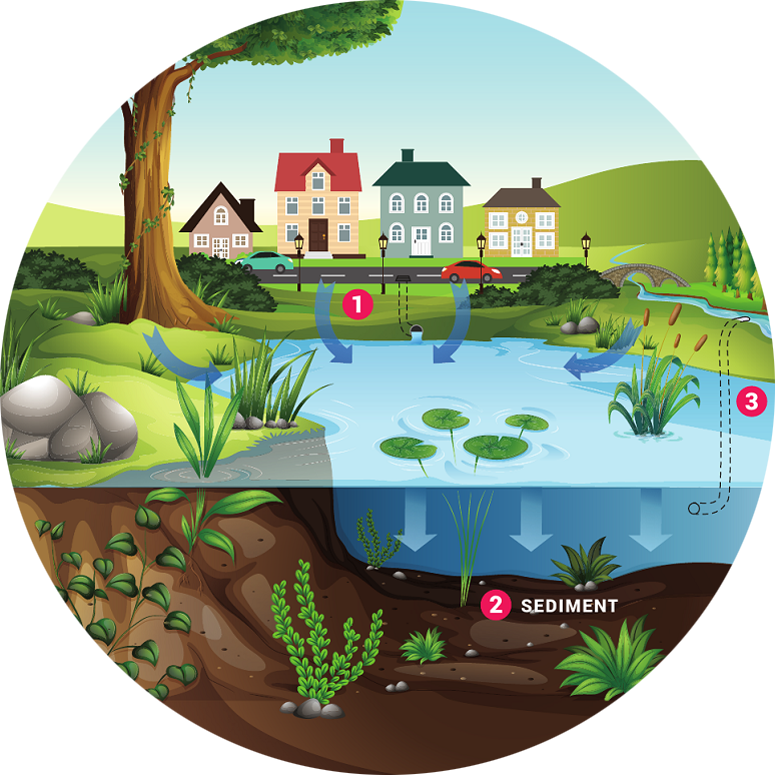Stormwater Management Ponds

For additional information or to submit a question
A stormwater management pond is a man-made infrastructure built to gather rainfall and surface water runoff.
How a storm pond works
- Stormwater runs off of our roads, driveways, sidewalks and throughout our community collecting dirt, litter and other pollutants before draining into the stormwater pond.
- Sand, dirt, silt and other sediments that pollutants attach themselves to settle to the bottom of the pond.
- Cleaner water leaves the stormwater pond and flows into our watercourse.
Benefits of stormwater management ponds
In a natural environment, rain easily soaks into the soil or is absorbed by trees and plants. In developed areas where the ground is mostly covered in hard surfaces such as roads, sidewalks, patios, and rooftops, rain cannot be fully absorbed, which leads to runoff. Water travels quickly over these hard surfaces to our natural waterways. Stormwater management ponds are designed to intercept water from draining directly into our waterways and serve various functions, including:
- Collecting runoff to reduce flooding and pollution
- Removing sediment particles that pollutants attach themselves to. The clean water is then returned to our waterways
- Providing flood protection to downstream properties by providing a space for the additional runoff to be detained

The City of Hamilton carries out these activities for the ponds that we own and operate:
- Annual inspection
- Monitoring sediment depths
- Monitoring invasive vegetation
- Maintenance of nearby vegetation and plants
- Maintenance of structures including fencing and gates
- For significant works, like cleaning out the sediment and making repairs to the facility slopes or infrastructure, the City will retain the services of a contractor
Residents should follow these suggestions to help keep our waterways clean:
Do
- Report illegal dumping by registering a by-law complaint
- Pick up after your pets
- Obey all signs posted around the ponds
Don’t
- Litter in or around the pond
- Over-fertilize or over-water your lawn and garden
- Dispose of your grass clippings or yard waste into the pond
- Disturb plants and vegetation around the pond
- Dispose of pet fish in the pond
- Drain or dispose of swimming pool chemicals and water in the pond or storm sewers
Residents should obey these guidelines to promote safety in and around the ponds.
- Do not swim, skate, wade, fish, or boat within the stormwater pond
- Practise safety when around a stormwater pond as water levels can change quickly during storm events
Looks Can Be Deceiving
Stormwater management ponds in the City of Hamilton are not monitored for ice conditions. Due to their function, they behave differently than natural bodies of water. They are unsafe to be on for several reasons.
- The ice depth varies across the pond’s surface
- Due to the continuous flow of water in these ponds, the ice that forms in winter is unstable
- Ponds collect runoff from the roadway that contain salt, which lowers the freezing temperature of the water
- Air pockets can easily form throughout the surface
- Ponds are typically located in remote or hard to access areas, distant from help
- It is dangerous to be on any ice surface that has areas of open water. Always stay off stormwater management ponds.
Stormwater Pond Dredging
Stormwater management ponds are considered sewage works under the Ontario Water Resources Act and maintenance and dredging activities are conditions of the Environmental Compliance Approval (ECA). As a result of sediment build-up, stormwater management ponds require dredging periodically to restore storage capacity, ensure proper retention time, improve water quality, and reduce the potential for flooding.
The Ministry of the Environment, Conservation and Parks (MECP) Stormwater Management Planning and Design Manual (2003) details that once the sediment level in the stormwater management pond reaches a certain threshold, dredging should occur to remove the accumulated sediment to ensure the pond can continue to provide the designed functions.
Planned Maintenance Projects for 2025
- SWMF 4 – Jerseyville Road West / Meadowbrook Drive - Ongoing
- SWMF 66 – Fifty Road / North Service Road - Ongoing
- SWMF 79 – Binbrook Road / Regional Road 56 - Complete
- SWMF 86 – Upper Ottawa Street / Lincoln M. Alexander Parkway - Complete
- SWMF 93 – Binbrook Road / Bradley Avenue - Deferred to 2026
- SWMF 110A – East of Red Hill Valley Parkway north bound at end of Greenhill Avenue on-ramp – Deferred to 2026
- SWMF 113 – East of Red Hill Valley Parkway north bound between Queenston Road and Barton Street East – Deferred to 2026
- SWMF 120 – Wilson Street West / Meadowbrook Drive - Complete
- SWMF 60A – Scenic Drive / Gem Court / Redfern Avenue / Sanatorium Road - Ongoing
- SWMF 5E – Cormorant Road / Osprey Drive - Ongoing
Planned Maintenance Projects beginning March 2026
- SWMF 23 – Sulphur Spring Road / Woodview Crescent
- SWMF 109 – West of the Red Hill Valley Parkway / behind Rosedale Park
- SWMF 110A - East of Red Hill Valley Parkway north bound at end of Greenhill Avenue on-ramp
- SWMF 112 – Red Hill Valley Parkway / Highway 8 / Pottruff Road North
- SWMF 113 - East of Red Hill Valley Parkway north bound between Queenston Road and Barton Street East
- SWMF 117 – West of the Red Hill Valley Parkway / Red Hill Trail / The Bear Meeting Place
- SWMF 27 – Carlisle Road / Wildberry Way
- SWMF 41 – Blueheron Lane / Centre Road
- SWMF 86 – Upper Ottawa Street / Lincoln M. Alexander Parkway
- SWMF 155 – Greti Drive / Turi Drive
- SWMF 93 – Binbrook Road / Bradley Avenue
